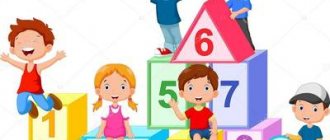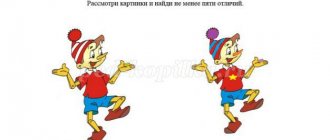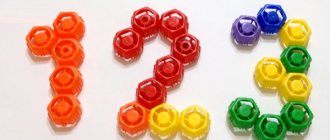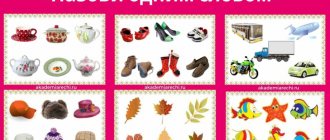Even the youngest children are happy to participate in the process of playful self-massage, often showing creativity, offering new movements, options for performing exercises, and at the same time receiving basic ideas about their own health, acupuncture, and the ability to improve their health with just the touch of their hands. Children's self-massage, with its simplicity and accessibility, the ability to organically include it in various types of activities, through the free expression of emotions, helps to strengthen the physical and mental health of children.
Self-massage for preschoolers is accompanied by funny poems designed to play up the massage movements, bright images that arouse the interest of children, allowing them to relax without thinking about the therapeutic effect of the exercises.
see also
Children's physical exercises - health-saving technologies Prevention of flat feet - health-saving technologies Relaxation during physical education classes - health-saving technologies
Using children's self-massage in physical education classes
When choosing health-saving technologies for working with children, based on medical indications, age characteristics and diagnostics of the physical development of children, I came to the conclusion that play self-massage is quite appropriate in the water and final part of physical education classes, as well as between performing certain basic movements to relieve tension. Self-massage allows you to enhance the effect of practicing positive emotions, arouse interest in taking care of personal health, and form the habit of a healthy lifestyle. It is important to teach children to perform massaging movements gently, effortlessly, lightly stroking, or lightly pressing on parts of the body, in the direction from the periphery to the center.
Massage techniques
- pressing
- stroking
- tapping
- kneading
- trituration
- topping
Expected results of massage
Educational direction
- mastering the rules of self-massage
- mastery of the simplest self-massage techniques
Wellness direction
- improved blood circulation
- improvement of metabolic processes
- strengthening the arch of the foot
- positive effect on the central nervous system
Educational direction
- encouragement of activity
- development of creative abilities
- development of positive emotions
The simplest types of self-massage
Foot massage
- clenching and unclenching of toes
- walking on massage mats
- walking along ribbed paths
- walking on toes, on heels
Massage of fingers and palms
- stretching each finger with light pressure
- lightly rubbing each finger without twisting (as if putting on a ring)
- various finger gymnastics
- rubbing the palms
- clapping hands
Hand massage
- stroking the arms from the hands to the shoulders
- tapping hands from hands to shoulders
- rubbing the forearms
Foot massage
- stroking from foot to thigh
- patting from foot to thigh
Back massage
- using a gymnastic stick
- using friendly help
Body massage
- side pinching
- stroking the abdomen with light circular movements clockwise
- stroking the center line of the chest with movements from bottom to top
Head massage
- stroking the head with hands from top to bottom
! Facial massage during physical education classes is unacceptable, as children’s hands may not be clean.
Self-massage for children in verses in kindergarten
Self-massage for children in verse in kindergarten
The main goal of this event is to relieve nervous tension, general relaxation, and improve the functioning of internal organs and vital systems. All exercises should be performed with a positive attitude and bring pleasure, otherwise the effect will be insignificant. Acupressure massage for children in verse in kindergarten is an opportunity to instill in your child the habit of proper leisure time, which contributes to the development of both speech skills and muscle development. You should start with your hands, moving to your feet and ending the session with stroking your head. Basic conditions for self-massage for children:
- do not use too much force when pressing on the indicated points;
- movements should be smooth, massaging;
- it is necessary to move in the direction from the periphery to the center, that is, from the hands to the shoulder;
- you should start with stroking, then move on to rubbing the body, kneading and vibration, that is, shaking.
Having mastered this technique, the baby will be able not only to properly massage his legs and arms, but also provide first aid in case of a bruise, for example, or independently cope with goosebumps, which frighten many. The duration of the exercises is 5-10 minutes per day. It is best to do them in the morning before traditional gymnastics and after an afternoon snack, when there is still a lot of time before sleep, but the main period of wakefulness is behind.
Self-massage for children in verses in kindergarten
To make this process even more fun, many pediatricians recommend turning it into a game, teaching the little ones simple poems that need to be recited while rubbing or stroking your own body. Hand massage: Starting position: sitting on the floor or chair, hands in front of you. The child begins to slowly rub his hands, saying: Ay tari, tari, tari, I’ll buy Masha amber. If I have some money left over, I’ll buy Masha some earrings. If I have some nickels left, I’ll buy Masha some shoes. If I have some pennies left, I’ll buy Masha some spoons. If I have some pillows left, I’ll buy Masha some pillows. With each line the pace of rubbing should increase. Number of repetitions: 2-3. Afterwards, they warm the throat with warm palms, clasping it from all sides. Like in our garden, how many flowers are blooming: roses, poppies, marigolds, asters, variegated flowers, dahlias and gillyflower. Which one do you choose? This rhyme is suitable for bending and straightening your fists. Alternate massage of the fingers (each finger must be rubbed separately) is carried out under the following words: We baked pancakes: The first one was given to the bunny, the bunny was given to the bunny. And the second fox, the red-haired sister. The third was given to the bear, the brown brother. Damn the fourth - a cat, a cat with a mustache. The fifth pancake has been fried and we will eat it ourselves. Foot massage: Use your palms to pat yourself from the ankles to the thighs. Then the legs are rubbed with the edges of the palms and then with the fists. All this time you should say: Toki-toki, toki-toki, the hammers are knocking. Knock-knock-knock-knock, hammers clattered. Knock-knock, knock-knock, the hammer is knocking.
Foot massage: Starting position: sitting on a chair, crossing one leg over the other. At the same time, it is easy to reach your feet with your palms and begin rubbing and kneading them. Bye-bye-bye, let's buy my son boots, put them on his little feet, and let him walk along the path. Your son will walk and wear new felt boots. Head massage: A circular massage of the skull is carried out as follows: the right palm strokes the right temple, moving towards the back of the head. At this time, massaging movements are carried out on the forehead with the left hand. All this is done to the rhyme: A hedgehog climbed onto the chest of drawers. His legs are not visible. He, such a feisty one, has uncombed thorns: And you can’t tell - is it a brush or a hedgehog? Then the soap jumped up, and grabbed my hair, and fussed, and lathered, and bit like a wasp. And from the mad washcloth, I ran away like from a stick, And she rushes after me, And bites like a she-wolf. Self-massage can be carried out using various improvised objects that can have a relaxing and pleasant effect on the body (for example, “rolling” spools of thread over the legs and arms can be a pleasure). The main thing is to explain to the baby that all this is very useful, and that the muscles need to be given a break from time to time, because otherwise there will be much less strength.
Self-massage during physical education classes
Massage of hands, fingers
Goal: to teach children to independently warm their hands during the cold season, relieve tension in their hands and fingers, help improve blood circulation, and develop fine motor skills. Self-massage “Making Fire” Everyone will need a polished wooden stick, for young and middle-aged children the sticks are in plain sight, for older children the sticks are hidden, you first need to find them; We vigorously twist the stick between our palms so that it becomes hot. Take the stick in the palm of your hand. We will make fire, twist the stick vigorously - and we will make fire for ourselves. Self-massage “We will warm our hands” The younger and middle age simply rub their palms to make it hot, the older age begin to rub their palms from the little fingers, gradually including all fingers, then rub their palms to make it hot, then spread their palms, trying to feel the “warm” between them ball" Oh-oh-oh, oh-oh-oh! How cold it is in the winter, So that we don’t get sick We need to rub our hands Self-massage “Kolobok” Young and middle-aged children imitate movements in a plane, older children start in a plane, end with their fingertips, as if a bun is between the palms, changing the direction of movement several times We put the dough in our hands Let's take it and start rolling it. The result is Kolobok Kolobok - ruddy side
Self-massage “We are having a lot of fun” Performed at the end of a physical education lesson; hands raised up Let's clench our fists tightly, And then we'll unclench them Let's unclench and squeeze them We're living a very fun life! Self-massage “Our hands will rest” It is carried out after exercises in throwing, climbing on a gymnastic wall; supporting one hand in the wrist with the other, shake it slightly Oh, our hands are tired. We’ll take the handle with the handle so that the hands can rest. Let’s shake the handle with the handle. Self-massage “Where are the hands” It is carried out after exercises in crawling, climbing; stretch your arms forward, raise them up and freely “throw” them down. These are your hands. All your palms are in sight. Now drop your hands. I’ll go look for them now.
Head massage
Goal: to teach children to relieve tension, restore attention, help improve blood circulation Self-massage “Hedgehog” After active play, younger and middle-aged children perform stroking movements with both hands from the forehead to the back of the head, then move their fingers on the sides from the base of the skull to the top of the head; The elders, lightly pressing on the skin with the fingers of their right and left hands, stroke the temples, moving first to the forehead, then to the back of the head, after which with their middle fingers they do acupressure at the base of the skull. A Hedgehog sat on a stump. The hedgehog’s legs are not visible. And you can’t tell at all. Is it a brush or a hedgehog?
Back massage
Goal: relax the back muscles, improve blood circulation, help friends Self-massage “Happy Rain” Children stand in a circle one after another, so that it is convenient to perform manipulations on the back of the person in front. First they clap their palms, then they tap their fingers, they pound their fists, at the end they stroke The rain went out for a walk Drip, drip, drip, He ran down the alley Drip, drip, drip, Children sit at home Drip, drip, drip, And don’t go out for a walk Drip, drip, cap When I leave, then come out here, everyone. Self-massage “Two cheerful geese” After the active game “Find yourself a mate”, two children massage each other’s backs in turns, the massage is performed simultaneously with both hands, children of the junior and middle groups simply poke their fingers, children of the senior and preparatory groups perform pinching, which allows In addition to fine motor skills, the “massage therapist” must develop coordination of movements. Two cheerful geese went out onto the meadow, nibble the grass, shouted merrily Ha-ha-ha, ha-ha-ha With the last words, the children change places Self-massage “Turtle” Performed in pairs, first lightly patting the back with palms from top to bottom, then vigorously pinching from the lower back upwards on the back
A turtle went for a swim and bit everyone out of fear: bite-bite-bite, bite I’m not afraid of anyone. With these words, quickly turn around and scare your partner “Uh!” and slow vibrating movements with the hands. Act scared Switch places
Self-massage “About little frogs” It is performed in a formation in a circle, first patting the palms on the back up and down, then pinching the arms from the elbow joints to the shoulders, then lightly tapping the fists on the back, at the end they freeze, depicting a roof over the head. Rain, rain More, more, there will be a holiday for the frogs, Thunder struck Bom-bom! All the frogs quickly enter the house.
Foot massage
Goal: prevent flat feet, strengthen the arch of the foot, improve blood circulation, develop fine motor skills of the fingers. Self-massage “Little Goat”
First, young and middle-aged children jump in place, older children step without lifting their socks off the floor in place, then the younger ones sit on the floor and stroke their legs with their palms from the feet upward, the older ones perform rubbing from a standing position, then alternately stretch one or the other the other leg and rotate the feet to the sides, the younger ones using the hands. At the end they perform jumps on the spot.
The goat jumped quickly and accidentally fell. The little goat sprained his leg. He sat down and cried on the path. I’ll tell you all, it’s not interesting without a game. The goat needs to play and jump with the kids.
Complex self-massage
Goal: to enhance the effect of practicing positive emotions, to arouse interest in taking care of personal health, to increase blood circulation, to improve metabolism Self-massage “Cockerel” Children line up in a circle, perform the suggested stroking movements, at younger and middle ages they repeat after the physical education instructor, at older ages - on one's own.
We made a cockerel. It is not painted yet. Let's take bright paints and start painting. We'll paint the crest with gold. We'll paint the wings and belly with yellow. We'll paint the back with red. Standing in front of each other. Now it's time for the legs. Let's paint the legs boldly. And now we need to paint the tail with seven stripes. Everyone tried, they weren't lazy. This is what the kids got: Golden combs.
Foot massage
The bear walked and walked (we plow our knuckles along the entire length of the foot) He came to the forest. (put a point with your fist) He took a saw and sawed, sawed, sawed (the entire surface of the foot was rubbed with the edge of his palm) He took an ax and chopped, chopped, chopped (again, the chopping movements were imitated with the edge of his palm) He took a hammer and hammered in nails (the fist imitated the movements of hammering nails) I straightened the leaves (massaging my fingers, each separately) I took a brush and painted it (affectionate stroking) Oh, what a great fellow! A wonderful craftsman! (kiss on the heel, the child is delighted, although, apparently, a little ticklish) *** Wall-wall (cheeks tickle) Ceiling (forehead tickled) Two steps (stepping movements of fingers on the chin and lips) Dziiin! Ring! (press the nose as if it were a bell button)
We recommend reading: Sleeping in the fresh air: what happens to the body?
Swift:
And here’s another fun thing: I put the child on my lap and ask - Is the accordion player at home? (The child answers or waves his head “at home-at home”) - Is the accordion ready? (Ready!) - Can I play? (Here are the options: “Yes” - I’m playing , I tickle the ribs, “No!” - “Well, I’ll come later,” and all over again. The “no!” option is extremely rare, the son wants to be tickled)
streKozuchka:
There is also a facial massage: forest - we run it through the hair, a clearing - along the forehead, a hillock - we run it along the nose, a hole - the child opens his mouth and finger “Am!” Tancha:
... and continuation: down the chin - “cliff”, pry the chin from below with your finger so that the mouth slams shut - “explosion” (well, carefully, of course, without extremes)





